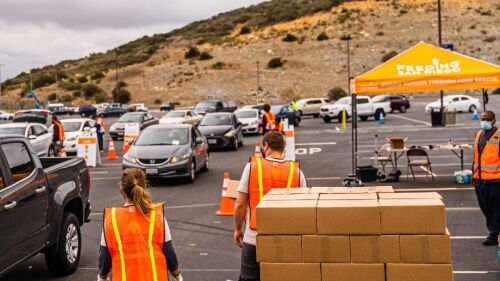Barrio Logan’s iconic Chicano Park turns 52 on Fri., April 22, and if those vibrant walls + murals could talk — well, they’d have a lot to say.
The designated National Historic Landmark has long been a symbol of Latino activism and community, so we’re touching on its history and how the park’s street art speaks volumes — “hasta la bahia,” or “all the way to the bay.”

A glimpse at some of the murals of Chicano Park. | Photo via @jaimeben
The 7.4-acre Chicano Park is located beneath the San Diego-Coronado Bridge, in the heart of one of San Diego’s oldest Mexican-American neighborhoods. More than 80 vibrant murals cover its walls + concrete pillars, making this the largest concentration of Chicano murals in the world, according to the San Diego Tourism Authority.
In December 2016, Chicano Park was designated a National Historic Landmark for its social, cultural + political significance in our city and beyond. But like its murals that tell of the Chicano community’s struggles and perseverance, the road to that recognition wasn’t easy.
In the 1960s, industrialization shook up Barrio Logan. The opening of Interstate 5 split the neighborhood in half and coupled with the 1969 debut of the San Diego-Coronado Bridge, thousands of barrio families were displaced.
The Chicano community wanted a space to call their own. They wanted a park.

The “Historical Mural” at the landmark was created in 1973 and restored in 2012. | Photo via @mw_43822
Residents were promised the land underneath the bridge would be turned into a park, but on April 22, 1970, San Diego City College student Mario Solis spotted construction crews and bulldozers in the area — preparing to build a California Highway Patrol station, not a park.
Mario — sometimes called the “Paul Revere of Chicano Park” — rushed back to the college and alerted students. Hundreds of locals rallied to halt construction, forming a human chain around the bulldozers and occupying the site for 12 days.
The takeover was followed by months of negotiations but locals and the Chicano Park Steering Committee (CPSC) — a group formed to direct the barrio’s efforts to form the park — held their stance. The formation of Chicano Park was signed into law in 1971 and, by 1973, the painting of the murals began.
Pro tip: The late Ramon “Chunky” Sanchez’s “Chicano Park Samba” tells the history of the park in song. Give it a listen.

Chicano Park is in the heart of Barrio Logan. | Photo via @streetart.atraverslemonde
🎨 The murals
More than five decades later, the colorful art of Chicano Park stands tall + strong — saying “si se puede.”
The CPSC says the park symbolizes “the struggle for self-determination and self-empowerment.”
Many local artists have added their work to the park over the decades including Salvador Torres, Salvador Barajas, Guillermo Aranda, Yolanda Lopez, Victor Ochoa, Armano Nuñez, and Guillermo Rosette — to name a few.
In June 2011, the Chicano Park Mural Restoration Project began working to restore 18 of the artworks painted on the columns + retaining walls of the bridge. According to the CPSC, the first five murals to be completely restored during that time were:
- “Undocumented Worker”
- “Chicano Park Takeover”
- “Los Niños del Mundo”
- “Aztec Archer”
- “Varrio Logan”
Murals continue to be added to the site today. The CPSC maintains this map of the murals — a good resource to check out before your next visit.
📍How to visit
Chicano Park is tucked between Logan + National avenues, right underneath the on-ramp to the bridge. It’s free to visit and also features gardens, playgrounds, and picnic areas.
Chicano Park Day is held annually on April 22 to celebrate the importance of the site. This year’s event will be virtual.











